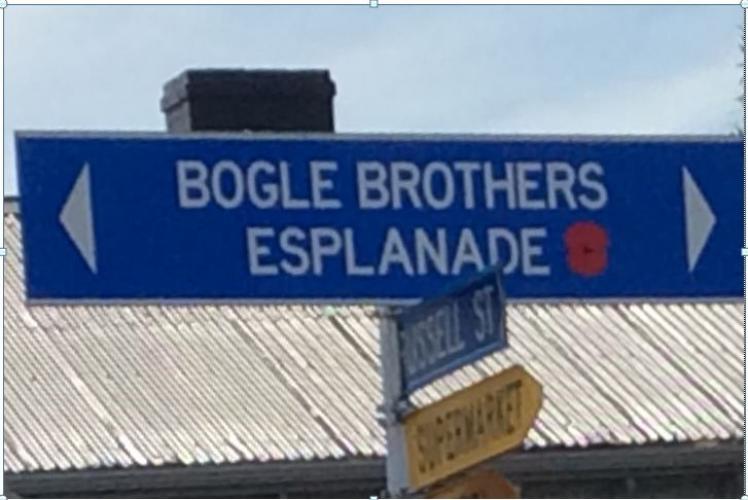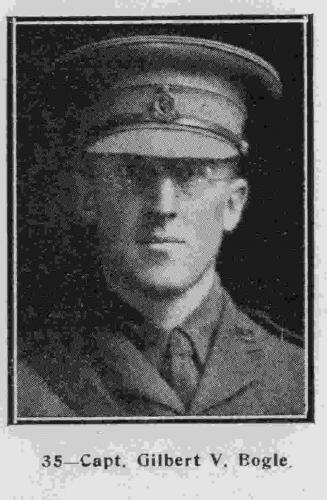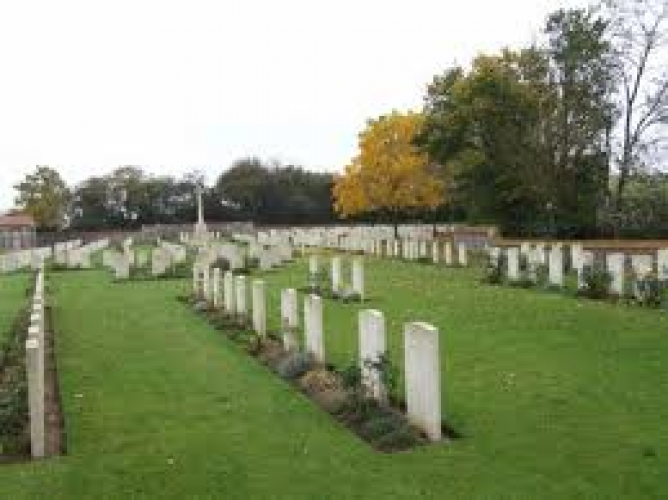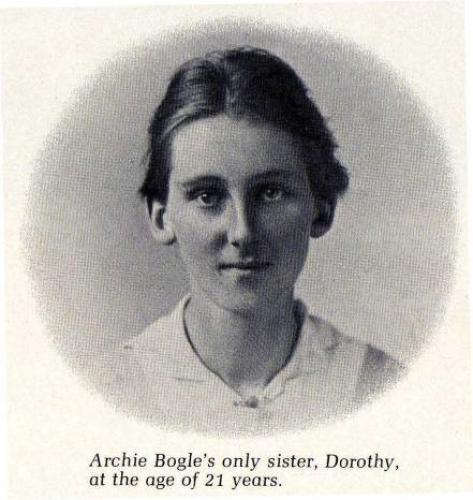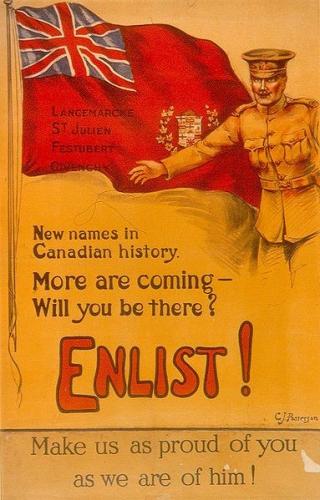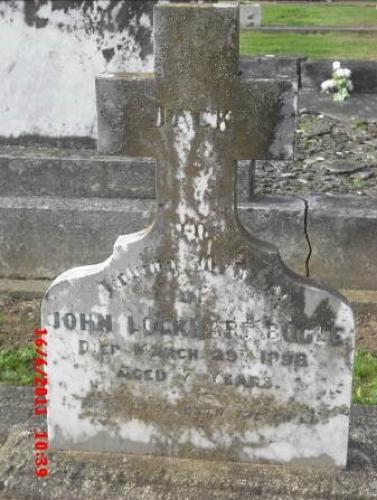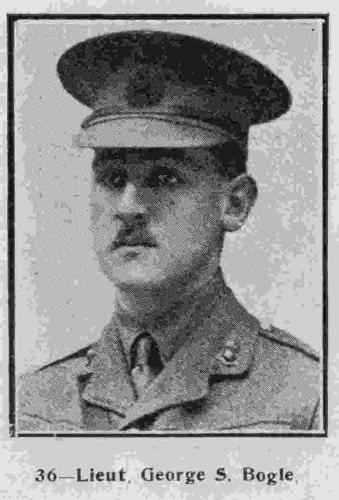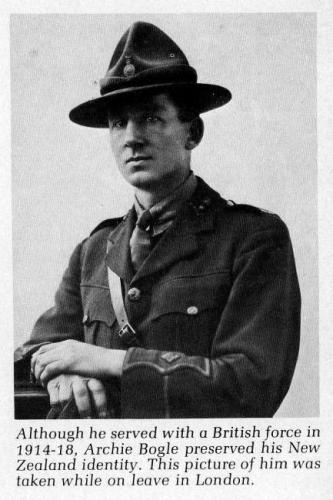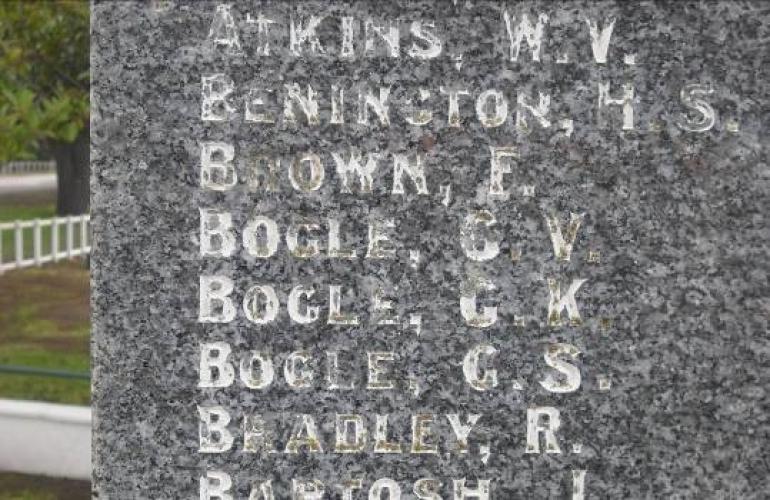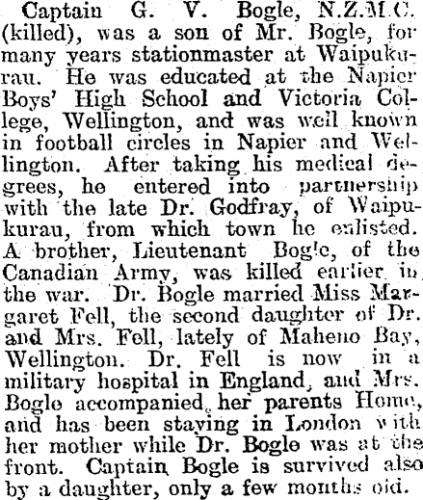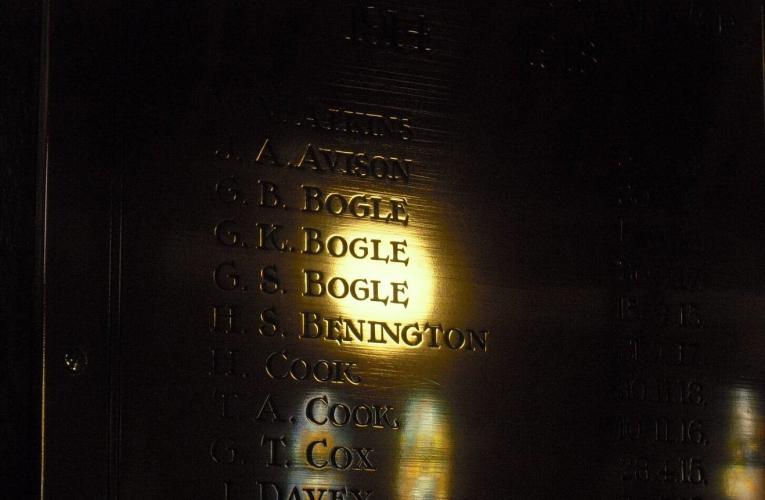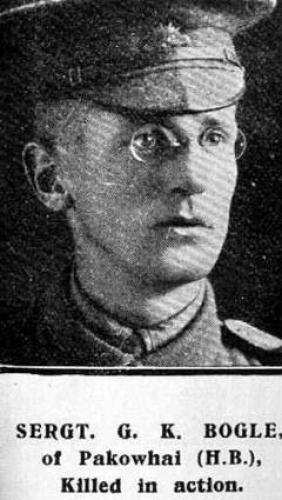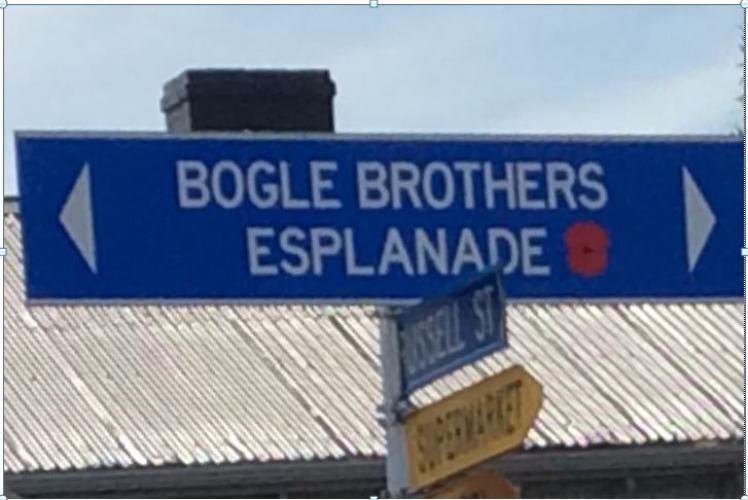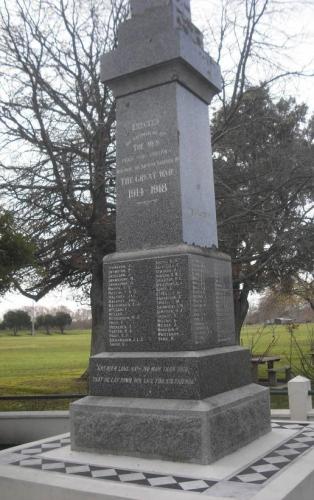031 Bogle Esplanade Waipukurau, sign blade with a poppy
Reason for the name
For forty years I have been aware that the Bogle family of Waipukurau lost three sons in the First World War. Having lived in the town for thirty years, I am often reminded of them. Their names and their dates of death are inscribed on the cenotaph in Waipukurau, and on a polished brass plaque of war dead at the rear of the north wall of St Mary’s Church, Waipukurau, as well as on the recently installed honours boards at Central Hawke’s Bay College, where the names of the fallen from Waipukurau and Waipawa in both World Wars are commemorated. They also appear on the roll of honour in the Hunter Council Chamber at Victoria University, which they all attended.
The story of the James and Annie Bogle’s family is a gloomy one, marred by the premature deaths of four out of six siblings, one through childhood misadventure, and the other three in war. As a lifelong teacher of English, in this article I have tried to link the stories of the three soldiers with the feelings expressed in a number of poems from the period.
Authors: Jeremy Ballantyne, Waipukurau, Hawke’s Bay, and Ethna Renna
THE PARABLE OF THE OLD MAN AND THE YOUNG
So Abram rose, and clave the wood, and went,
And took the fire with him, and a knife.
And as they sojourned both of them together,
Isaac the first-born spake and said, My Father,
Behold the preparations, fire and iron,
But where the lamb for this burnt-offering?
Then Abram bound the youth with belts and straps,
And builded parapets and trenches there,
And stretchèd forth the knife to slay his son.
When lo! an Angel called him out of heaven,
Saying, Lay not thy hand upon the lad,
Neither do anything to him, thy son.
Behold! Caught in a thicket by its horns,
A Ram. Offer the Ram of Pride instead.
But the old man would not so, but slew his son,
And half the seed of Europe, one by one.
Wilfred Owen (1916)
The boys’ father was James Kennedy Bogle, born on 14 December 1845 in Glasgow, Lanark, Scotland. His mother was Jane, a daughter of James Bell, a Scotsman who became British Superintendent on the Mosquito Coast, near Nicaragua. Her younger sister married Gustav von Tempsky who was so prominent in the New Zealand Wars. These family connections may help to account for the strong element of adventure in younger generations of the family and to illustrate the Bogle family motto “Spe meliore vehor” – I sail on in better hope.
Sketchy details of James’s eventful life were outlined in the obituary notice published following his death in Hastings, New Zealand, in 1939:
"With the death yesterday of Mr James Kennedy Bogle, of Middle Road, Havelock North, New Zealand has lost another of its early pioneers and Hawke's Bay one of its long-standing and highly respected citizens. Mr Bogle was 93 years of age. Born at Helensburgh near Glasgow, Scotland, he set sail with his parents for Australia when only a lad of seven. When he was only 18 he heard news of the Reefton gold rush in New Zealand, but he crossed to this country too late to be successful. Undaunted by this temporary setback he loaded his pack on his shoulders and tramped down the West Coast. In those days bridle-tracks had to be traversed for the most part, and in places there was not even so much as that. The going was hard, but eventually he was rewarded by securing semi-permanent work as a ferryman on the ClarenceRiver.
James joined the Armed Constabulary during the Maori War. On coming to the North Island he took an active interest in the flax industry in the Waikato, where he was joined by his brother, William. After a few years the brothers moved to Hawke’s Bay where they played a part in the development of this province by their assistance in surveying and laying the railway tracks between Waipukurau and Napier. Once the railways opened their interest in this service was maintained by their appointments to posts as stationmasters. The late Mr Bogle was a familiar figure as stationmaster at Waipukurau for a period of 36 years, and his brother was equally well-known in a similar position at Napier. On his retirement from the railway at Waipukurau in 1910 at the age of 64, Mr Bogle, still an active man, took up fruit farming in the Pakowhai district where he remained for a few years before taking up residence in Middle Road, Havelock North, where his death occurred."
On 22 April 1882, James Bogle married Annie Stafford Groombridge in Waipukurau, New Zealand. She was born in January 1858 in Hackney, Greater London, and died in Havelock North in 1942.
While his obituary notice hints at James’ strong, resourceful and adventurous character, it says nothing of the numbing grief that the couple surely experienced when three of their sons were killed in action in the war in 1915, 1916, and 1917.
ANTHEM FOR DOOMED YOUTH
What passing-bells for these who die as cattle?
Only the monstrous anger of the guns.
Only the stuttering rifles' rapid rattle
Can patter out their hasty orisons.
No mockeries now for them; no prayers nor bells,
Nor any voice of mourning save the choirs,--
The shrill, demented choirs of wailing shells;
And bugles calling for them from sad shires.
What candles may be held to speed them all?
Not in the hands of the boys, but in their eyes
Shall shine the holy glimmers of good-byes.
The pallor of girls' brows shall be their pall;
Their flowers the tenderness of patient minds,
And each slow dusk a drawing-down of blinds.
Wilfred Owen (September-October 1917)
The Bogles had six children altogether. Their youngest son, Jack (John Lockhart), was only seven when he died on 29 March 1898, but the others all grew to adulthood. Jack’s grave is in the cemetery, Waipukurau (corner of Porangahau Road and Lake View Road).
Their only daughter, who followed five older brothers, was Dorothy, born in 1893, who married George Northcroft in 1926.
The eldest son was Archibald Hugh Bogle. Born on 19 January 1883 in Waipukurau, Archie registered as a surveyor as a young man, and became a leader in his profession, towards the end of his writing a well-known book on New Zealand field surveying, “Links in the Chain”. (I have borrowed from the foreword to this book, by his old friend, Sir David Smith.) “When the First World War came in 1914, Archie had a wife and child to support, but in September 1915, his brother, Stafford, was killed at SuvlaBay, on Gallipoli, and Archie wanted what he called “a crack” at the enemy. So when, about that time, the Chief of the New Zealand General Staff appealed for men with engineering experience to enlist, because the army engineers were short of officers, Archie enlisted in the New Zealand Expeditionary Force and fought in France in 1916 & 1917. He embarked with the 16th Reinforcements of the New Zealand Engineers on 19 August 1916 in Wellington, eventually being promoted to the rank of Major.
“The loss of all his brothers struck deeply into Archie’s consciousness. There were times long after the war when he wondered why his family should have suffered so severely, sometimes dwelling on the quenching of the promise of Gilbert, whom he had helped through his medical course.”
Archie came through the war unscathed, and died in Auckland in 1972 after a long and illustrious life. His younger brothers were not so fortunate.
GEORGE STAFFORD BOGLE
The fourth son in the Bogle family, but the first to lose his life overseas, was Stafford, who was born on 11 July 1889, in Waipukurau. Like his other brothers, he enlisted, and joined the Canadian Expeditionary Force (Royal Canadian Engineers) where his rank was 2nd Lieutenant.
His attestation papers (above) show his keenness to enlist. His occupation is listed as civil engineer, and he had had four years serving in the NZ territorials. He was 5’10½” tall. On 23 September 1914, he presented himself (along with 32,000 young men in the same month) to the medical officers at the new Canadian military training camp at Valcartier, near Quebec, and was passed fit for active service. The expeditionary force sailed for England on 3 October, arriving on the 14th. Quite why Stafford was in Canada at that time is unclear, but just over a year later, he was killed during the Gallipoli campaign.
During February 1915, the 1st Canadian Division began moving to France, and was made responsible for 6000m of front near Fleurbaix. On 1 April they were moved north to the Ypres Salient, where in late April, during the Battle of Ypres, occurred the first use of poison gas against the Allied troops. On 5 May Lt-Col John McCrae of the Canadian Expeditionary Force composed the well-known poem In Flanders Fields.
Following action in France, the 1st Newfoundland Regiment landed at Suvla Bay in Gallipoli on 20 September, to augment and strengthen the Allied forces, including the Anzacs, who had been attempting to seize control of the Dardanelles from Turkey since the first landings on 25 April. At Gallipoli the Regiment faced snipers, artillery fire and severe cold, as well as the trench warfare hazards of cholera, dysentry, typhus, gangrene and trench foot. Over the next three months thirty soldiers of the regiment were killed or mortally wounded in action and ten died of disease; 150 were treated for frostbite and exposure. Despite the terrible conditions, the Newfoundlanders stood up well. When the decision was made to evacuate all British Empire forces from the area, the regiment was chosen to be a part of the rearguard, finally withdrawing from Gallipoli with the last of the British Dardanelles Army troops on 9 January 1916.
Unfortunately, this came too late for Lieutenant Stafford Bogle, who was sniped at the top of Suvla Hill on Friday 15 October and died of wounds. He was 26 years old, and is commemorated on the Helles Memorial, Turkey, one of 20771 names of soldiers whose final resting places are unknown, or who are buried at sea.
From AND THE BAND PLAYED WALTZING MATILDA
How well I remember that terrible day
When the blood stained the sand and the water,
And how in the hell that they call SuvlaBay
We were butchered like lambs at the slaughter.
Johnny Turkey was ready, he primed himself well,
He showered us with bullets and he rained us with shell,
And in five minutes flat he’d blown us all to hell…
Eric Bogle (1975) – (no relation)
GILBERT VERE BOGLE
Gilbert Bogle was born on 9 June 1884 in Waipukurau. In July 1915 he married Margaret Cecily Richmond Fell from Wellington. Although his parents had shifted from Waipukurau to Pakowhai when James retired as the stationmaster in 1910, Gilbert returned to live in Waipukurau following his graduation from medical school, and he went into practice with the hospital superintendent, Dr Godfray. He was a member of the Waipukurau Club (where is name is on the honours board in the foyer.)
Gilbert embarked on 9 October for France as a Surgeon Captain in the Earl of Liverpool’s own New Zealand Rifle Brigade Medical Corps, First Battalion. Margaret was pregnant with their child when he left.
In his critique of the war, “On My Way to The Somme” (2005), p.134-5, Andrew MacDonald writes:
“(At the) forward area, wounded of all nations collected at a cutting to the southwest of Flers known as Bogle’s Post. This was named after a 1st Battalion medical officer, Captain Gilbert Bogle, who worked there. Hundreds of wounded arrived at Bogle’s between 15 and 17 September; many of them were stretcher cases and unable to walk back. There they lay, many with hideous wounds, in pain and under constant shellfire.
“The Medical Corps suffered many casualties in the first days of the offensive, including Gilbert Bogle. By 21 September, the corps had lost five officers and 66 men killed or wounded.”
On Sunday 17 September 1916, Gilbert Bogle was killed in action during heavy shelling at Thistle Dump, near the Flers–
Longueval Road, Montauban, Somme. He was 32 years old, and is buried in the QuarryCemetery, Montauban. Following distinguished service he was mentioned in dispatches, and this and the manner of his death were announced in the London Gazette, 4 January 1917:
“For special devotion to duty at Flers on the 15th and 16th September 1916. Captain Bogle, New Zealand Medical Corps (Regimental Medical Officer attached 1st Battalion, 3rd New Zealand Rifle Brigade), established an aid station near Flers on 15th September and organised dressing and evacuation of wounded of his own and other units, a very large number passing through his station. He worked ceaselessly in the open under continual shellfire for 36 hours without rest or meals until he was killed by a shell five minutes before the Battalion moved out on relief on 16th September. His untiring efforts undoubtedly saved many lives and throughout he displayed an extraordinary devotion to duty. The work done by this officer since the arrival of his Unit in France last April has been exceptionally good. He has always shown great interest in his work and the low sick rate of his Unit is material proof of his excellent work.”
From DEAD MAN’S DUMP
Maniac Earth! howling and flying, your bowel
Seared by the jagged fire, the iron love,
The impetuous storm of savage love.
Dark Earth! dark Heavens! swinging in chemic smoke,
What dead are born when you kiss each soundless soul
With lightning and thunder from your mined heart,
Which man's self dug, and his blind fingers loosed?
A man's brains splattered on
A stretcher-bearer's face;
His shook shoulders slipped their load,
But when they bent to look again
The drowning soul was sunk too deep
For human tenderness.
They left this dead with the older dead,
Stretched at the cross roads.
Isaac Rosenberg (1918)
His reputation was widespread, and he was held in the highest regard: “In the field he was bold, resolute, resourceful and brave to a fault. He was not to be spared; we could ill afford to lose him. He was undoubtedly the best R.M.O. in the division. An Edinburgh rugby "blue," he was a leader in all forms of athleticism. He joined the 1st Battalion of the N.Z. Rifle Brigade in 1915, and sailed for Egypt in October, seeing service at Mersa Matruh during the Senussi rising. His brother officers of the battalion held him in the highest esteem, they found that to his men he was a real friend, trusted, beloved, and appealed to in every difficulty; no day's work was ever too long for him no duty too irksome. One officer of the battalion wrote of him:—"He was the finest gentlemen it has ever been my good fortune to meet. His capable and untiring work has been the admiration of us all; where all men were heroes his courage shone conspicuously. He always seemed so absolutely part of the battalion—in the mess— on the march—in the field, and was always so helpful to everybody that there is no one who could be so missed by officers and men." (“The New Zealand Medical Service in the Great War 1914-1918”; p 212)
GORDON KENNEDY BOGLE
Born in Waipukurau in May 1888, Gordon Bogle joined the Australian Imperial Force, 26th Infantry Battalion, 10th Reinforcements, which embarked on 28 March 1916 from Brisbane on the HMATCommonwealth. He was attested at Lismore, NSW, on 20 September 1915. His trade was listed as architect (formerly apprenticed to C. T. Natusch, Wellington.) He was 5’8” tall and weighed 137 lbs. Gordon stated that he had had some military experience in the form of two years of school cadets and six months in the NZ Artillery.
He became a sergeant in the battalion and fought mainly in Belgium where he was killed in action at the age of 29 on Thursday 20 September, 1917, during the Battle of Menin Road, which lasted for a week during the Battle of Passchendaele. He is commemorated on the imposing Menin Gate Memorial in West Flanders.
Some details of the Battle of Menin Road: 20–25 September 1917
“The plan of attack included special emphasis on the need for heavy and medium artillery. 1,295 pieces of artillery were allocated for the battle, equivalent to one artillery piece for every five yards of the attack front. The ammunition requirements for the seven days bombardment prior to assault was estimated at 3.5 million rounds. The British also sought to neutralize the German batteries with poison gas in the days before the attack, including gas attacks on each of the three preceding evenings before the assault.
“On 20 September, after a massive bombardment, the Allies attacked and managed to hold their objective of about 1,400 metres gained, despite heavy counter-attacks, suffering twenty-one thousand casualties. The Germans by this time had a semi-permanent front line, with very deep dugouts and concrete pillboxes, supported by artillery ranged on no mans land. The attack was a great success and caused no small panic to German commanders; proving quite clearly to them that well-prepared defences could no longer fend off a well-prepared attack under good conditions.” (Wikipedia article)
In the dreadful conditions that prevailed in this battle, Gordon Bogle was killed in action. The army wrote to his mother concerned at his ‘regrettable loss’. Annie was initially told that he was killed by shellfire in the attack on Broodsiende Ridge, and over a year later, in October 1918, she was informed that ‘he was killed instantaneously by a H. E. (high explosive) shell which struck his dugout in trench’ and that ‘no burial was effected’, which is unsurprising. He would have been blown to smithereens.
Gordon’s personal effects were sent to his grieving mother: 2 discs, wallet, notebook, photos, silver cigarette case. His father applied for his war medals - (1 British War Medal, 1 Victory Medal); and they arrived at his home at Pakowhai in May 1922, along with a memorial scroll signed by the King.
With three of their sons never to return from serving their country, it is not hard to feel deeply for James and Annie Bogle. All we have now are scraps of information, grainy photographs of the young brothers who were killed, and their names enshrined in brass or marble.
With the enormous loss of life during the war, it was natural for some of the later poets to be extreme in their cynicism and bitterness.
From HUGH SELWYN MAUBERLEY
Canto IV
These fought in any case,
and some believing,
pro domo, in any case. . .
Some quick to arm,
some for adventure,
some from fear of weakness,
some from fear of censure,
some for love of slaughter, in imagination,
learning later . . .
some in fear, learning love of slaughter;
Died some, pro patria,
non "dulce" non "et decor". . .
walked eye-deep in hell
believing in old men's lies, then unbelieving
came home, home to a lie,
home to many deceits,
home to old and new infamy;
usury age-old and age-thick
and liars in public places.
Daring as never before, wastage as never before.
Young blood and high blood,
fair cheeks, and fine bodies;
fortitude as never before
frankness as never before,
disillusions as never told in the days,
hysterias, trench confessions,
laughter out of dead bellies.
Canto V
There died a myriad,
and of the best, among them,
For an old bitch gone in the teeth,
For a botched civilization,
Charm, smiling at the good mouth,
Quick eyes gone under earth's lid,
For two gross of broken statues,
For a few thousand battered books.
Ezra Pound (1920)
POST SCRIPT: I have also learnt that Archie’s wife, Bertha Reeve, had three brothers killed in the war as well: Stanley (d22.8.1917); William (d29.3.1918); and Llewellyn (d13.11.1918).
|
Name: |
REEVE, STANLEY THORNTONSEYMOUR |
|
Initials: |
S T S |
|
Nationality: |
Canadian |
|
Rank: |
Lieutenant |
|
Regiment/Service: |
Canadian Infantry (Alberta Regiment) |
|
Unit Text: |
50th Bn. |
|
Age: |
35 |
|
Date of Death: |
22/08/1917 |
|
Additional information: |
Son of William Jesse and Bertha V. Reeve, of 13, Freyberg St., Lyall Bay, Wellington, New Zealand. Born at Waiau, Canterbury, New Zealand. |
|
Casualty Type: |
Commonwealth War Dead |
|
Grave/Memorial Reference: |
I. L. 9. |
|
Cemetery: |
AIX-NOULETTE COMMUNAL CEMETERY EXTENSION |
|
Name: |
REEVE, WILLIAM ALFRED CAMPBELL |
|
Initials: |
W A C |
|
Nationality: |
New Zealand |
|
Rank: |
Second Lieutenant |
|
Regiment/Service: |
New Zealand Rifle Brigade |
|
Unit Text: |
2nd Bn. 3rd |
|
Date of Death: |
29/03/1918 |
|
Service No: |
24/660 |
|
Additional information: |
Son of Bertha Violet Reeve, of Taranaki, New Zealand, and the late William Jesse Reeve. |
|
Casualty Type: |
Commonwealth War Dead |
|
Memorial: |
GREVILLERS (NEW ZEALAND) MEMORIAL |
|
Name: |
REEVE, LLEWELLYN WILLIAM PEARCE |
|
Initials: |
L W P |
|
Nationality: |
New Zealand |
|
Rank: |
Second Lieutenant |
|
Regiment/Service: |
Canterbury Regiment, N.Z.E.F. |
|
Unit Text: |
2nd Bn. |
|
Age: |
38 |
|
Date of Death: |
13/11/1918 |
|
Service No: |
33072 |
|
Additional information: |
Husband of Aileen A. M. Reeve, of Christchurch, New Zealand. |
|
Casualty Type: |
Commonwealth War Dead |
|
Grave/Memorial Reference: |
II. D. 5. |
|
Cemetery: |
BROOKWOOD MILITARY CEMETERY
|

